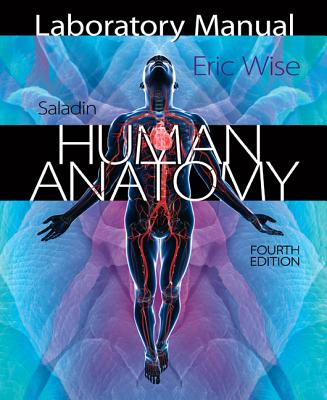Human Anatomy Lab Manual 4th Edition
- Human Anatomy Saladin 4th Edition Lab Manual
- Human Anatomy And Physiology Laboratory Manual 4th Edition
Authors Terry Martin and Cynthia Prentice-Craver combine passion for and experience teaching human anatomy and physiology with a commitment to developing curricula that stimulates student curiosity and enthusiasm, which results in a laboratory manual with an innovative, hands-on approach that benefits students. The Laboratory Manual for Human Anatomy & Physiology includes a main version, a cat version, and a fetal pig version. Each of these includes sixty-three laboratory exercises, three supplemental labs found online, and six cat, or fetal pig, dissection labs in corresponding versions. All versions are written to work well with any anatomy and physiology text.
New to this Edition Complete digital lab manual?with all pre-lab and post-lab questions?available on Connect. Brand new test bank with 20 unique questions for each exercise focused on mastery after lab completion.
Buy Human Anatomy Laboratory Guide and Dissection Manual 4th edition (473) by Mike T. Timmons for up to 90% off at Textbooks.com.
New exercise (56) on Metabolism. Added APR icons on the image sub-heading level for greater precision. Retained Features The procedures are clear, concise, and easy to follow. Relevant lists and summary tables present the contents efficiently.
Histology micrographs and cadaver photos are incorporated in the appropriate locations within the associated labs. The pre-lab section includes quiz questions.
CB/CD125 T &. CM125 C TVVinS. Manual by Jeremy Churchill with an additional chapter on the CB125 TD-J by Penny Cox. Honda cm 125 manual.
It also directs the student to carefully read the introductory material and the entire lab to become familiar with its contents. If necessary, a textbook or lecture notes might be needed to supplement the concepts. Terminologia Anatomica is used as the source for universal terminology in this laboratory manual. Alternative names are included when a term is introduced for the first time. Laboratory assessments immediately follow each laboratory exercise. Histology photos are placed within the appropriate laboratory exercise. A section called 'Study Skills for Anatomy and Physiology?
Is located in the front of this laboratory manual. This section was written by students enrolled in a Human Anatomy and Physiology course. Critical Thinking Activities and Assessments are incorporated within most of the laboratory exercises to enhance valuable critical thinking skills that students need throughout their lives. Cadaver images are incorporated with dissection labs. The instructor will find digital assets for use in creating customized lectures, visually enhanced tests and quizzes, and other printed support material. A correlation guide for Anatomy & Physiology Revealed? (APR) and the entire lab manual is available.
Contact your McGraw-Hill Learning Technology Representative. Cadaver images from APR are included within many of the laboratory exercises. Some unique labs included are 'Scientific Method and Measurements,? 'Chemistry of Life,?
'Fetal Skeleton,? 'Surface Anatomy,? 'Diabetic Physiology,? And 'Genetics.' The annotated instructor's guide for Laboratory Manual for Human Anatomy and Physiology describes the purpose of the laboratory manual and its special features, provides suggestions for presenting the laboratory exercises to students, instructional approaches, a suggested time schedule, and annotated figures and assessments. It contains a 'Student Safety Contract?


And a 'Student Informed Consent Form.' Each laboratory exercise can be completed during a single laboratory session. Learning outcomes with icons O have matching assessments with icons A so students can be sure they have accomplished the laboratory exercise content. Outcomes and assessments include all levels of learning skills: remember, understand, apply, analyze, evaluate, and create. Assessment rubrics for entire laboratory assessments are included in Appendix 2 Anatomy and Physiology Revealed 3.2 blends together detailed cadaver photos graphs with state-of-the-art layering technique to provide a uniquely interactive dissection experience.
Cat and fetal pig versions are also available. Physiology Interactive Lab Simulations (PHILS 4.0) is included with this lab manual. Eleven lab simulations with associated activities are located in Appendix 4, which a correlation guide is also included. BIOPAC exercises are included on four different body systems.
Systems use hardware and software for data acquisition, analysis, and recording of information for an individual.
. Twenty-seven concise lab exercises are included. A complete exercise on microscope use and care is included in the manual's Appendix A. A full-color, 55-plate histology atlas with photomicrographs that are referenced in appropriate figure legends throughout the lab manual.

A wide range of activities offer students varied, hands-on lab experiences to fit different learning styles. The art program includes figures and illustrations of exceptional detail, including extensive tissue tables with photomicrographs, and newly-rendered, realistic muscle art. A full-color, extensive Histology Atlas is included. Table of Contents Unit One: Human Body and Orientation 1.
The Language of Anatomy 2. Organ Systems Overview Unit Two: The Cell 3. The Cell - Anatomy and Division 4. Cell Membrane Transport Mechanisms Unit Three: Basic Tissues and the Skin 5. Classification of Tissues 6.
The Skin (Integumentary System) Unit Four: The Skeletal System 7. Overview of the Skeleton 8. The Axial Skeleton 9. The Appendicular Skeleton 10. Joints and Body Movements Unit Five: The Muscular System 11. Structure of Skeletal Muscle 12. Gross Anatomy of the Muscular System Unit Six: The Nervous System 13.
Neuron Anatomy and Physiology 14. Gross Anatomy of the Brain and Cranial Nerves 15. Spinal Cord and Spinal Nerves 16.
Human Reflex Physiology 17. The Special Senses 18. Anatomy and Basic Function of the Endocrine Glands Unit Seven: The Circulatory System 19. Anatomy of the Heart 21. Anatomy of Blood Vessels 22.
Human Cardiovascular Physiology–Blood Pressure and Pulse Determinations Unit Eight: The Respiratory System 23. Anatomy of the Respiratory System 24. Respiratory System Physiology Unit Nine: Other Major Systems 25. Functional Anatomy of the Digestive System 26. Functional Anatomy of the Urinary System 27.
Anatomy of the Reproductive System. About the Author(s) For Elaine N. Marieb, taking the student's perspective into account has always been an integral part of her teaching style. Marieb began her teaching career at Springfield College, where she taught anatomy and physiology to physical education majors.
She then joined the faculty of the Biological Science Division of Holyoke Community College after receiving her Ph.D. In zoology from the University of Massachusetts at Amherst. While teaching at Holyoke Community College, where many of her students were pursuing nursing degrees, she developed a desire to better understand the relationship between the scientific study of the human body and the clinical aspects of the nursing practice. To that end, while continuing to teach full time, Dr. Marieb pursued her nursing education, which culminated in a Master of Science degree with a clinical specialization in gerontology from the University of Massachusetts.
It is this experience, along with stories from the field–including those of former students, now in health careers–that has informed the development of the unique perspective and accessibility for which her texts and laboratory manuals are known. In her ongoing commitment to students and her realization of the challenges they face, Dr.
Human Anatomy Saladin 4th Edition Lab Manual
Marieb has given generously to provide opportunities for students to further their education. She contributes to the New Directions, New Careers Program at Holyoke Community College by providing several full-tuition scholarships each year for women returning to college after a hiatus or who are attending college for the first time and would otherwise be unable to continue with their studies without financial support. She funds the E. Marieb Science Research Awards at Mount Holyoke College, which promotes research by undergraduate science majors, and generously contributed to the University of Massachusetts at Amherst where she provided funding for reconstruction and instrumentation of a cutting-edge cytology research laboratory that bears her name. Marieb received the Benefactor Award from the National Council for Resource Development, American Association of Community Colleges, which recognizes her ongoing sponsorship of student scholarships, faculty teaching awards, and other academic contributions to Holyoke Community College.
Human Anatomy And Physiology Laboratory Manual 4th Edition
In May 2000, the science building at Holyoke Community College was named in her honor. Additionally, while actively engaged as an author, Dr. Marieb serves as a consultant for the Benjamin Cummings Interactive Physiology¨ CD-ROM series, and is an active member of the Human Anatomy and Physiology Society (HAPS), the American Association for the Advancement of Science (AAAS), and Sigma Xi. Anatomy & Physiology, Second Edition is the latest expression of her commitment to student needs in their pursuit of the study of A&P.